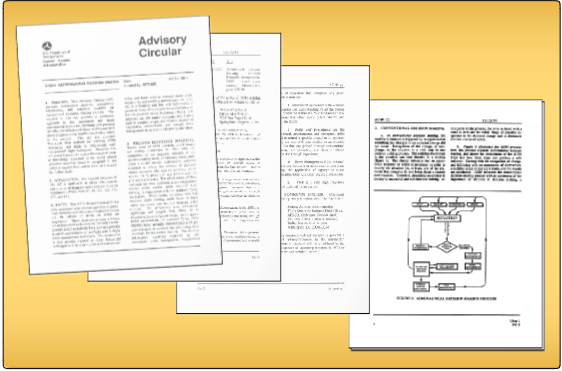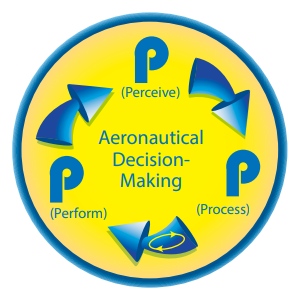Introduction
This chapter focuses on the pilot aeronautical decision-making (ADM) skills used to mitigate risk factors while in flight. Advisory Circular (AC) 60-22, Aeronautical Decision-Making [Figure 8-1], provides additional information, background references, definitions, and other pertinent information about ADM training in the general aviation environment and is available here.

Figure 8-1. Advisory Circular (AC) 60-22, Aeronautical Decision-Making, includes a wealth of information for pilots.
Accidents still occur despite advances in training methods, aircraft technology, and services available to pilots. Despite improvements in training and technology, human error remains an issue. ADM provides a foundation, which should help pilots avoid making errors in judgment.
Aeronautical decision-making (ADM) provides pilots with a structured framework of processes and procedures, which have a positive effect on managing hazards. ADM does not eliminate hazards, but helps the pilot address hazards and associated risks that threaten the safety of flight. ADM describes the ongoing process used by pilots to determine the best course of action when facing a given set of circumstances.
ADM Background
Before the development of ADM training, consensus held that good judgment resulted from experience gained during hours of accident-free flying. However, research done during the 1980s indicated that including ADM in training significantly reduced judgment errors among student pilots. In addition, an operator flying about 400,000 hours annually demonstrated a 54 percent reduction in the accident rate after adding ADM to recurrent training. Since ADM enhances safety, the Federal Aviation Administration (FAA) requires ADM training and testing.
Analytical Decision-Making
Several closed-loop models describe steps pilots should take when making decisions. For example, AC 60-22 contains information on the DECIDE Model, which pilots may wish to study and consider using. The following discussion describes the simpler 3P model, which stands for Perceive, Process, and Perform. [Figure 8-2] Using this model in flight continues the risk management activity taken before flight, and allows the pilot to address additional hazards while dealing with a higher workload.

Figure 8-2. The illustration shows how the 3P model is used in decision-making.
Perceive: While en route, for example, a pilot checks data-link weather on an electronic flight bag and sees thunderstorms developing ahead. The pilot perceives this as a significant hazard since the likelihood of a thunderstorm affecting the aircraft could be high and the consequences could be severe.
Process: The pilot considers the options available to mitigate the threat. Choices may include:
- Diverting to a nearby airport
- Turning back, if conditions allow
- Rerouting the flight to avoid the thunderstorms
- Flying above the weather.
During analytical decision-making, the pilot evaluates the pros and cons associated with each option and chooses one that should adequately reduce the level of risk. For example, the aircraft may not have the equipment or capability to fly above the weather or there might not be enough fuel on board for a significant reroute. In that case, the pilot excludes those two options. What the pilot decides depends on the available choices, training, experience, conditions, equipment, and pilot ability.
Analytical decision-making leads to an option likely to result in a safe outcome. Pilots should consider the following items less important than safety:
- Being on time
- Inconveniencing passengers
- Inconveniencing persons waiting at the destination
- Continuing to the original destination
Perform: After choosing a viable option, the pilot executes the changes. The choice made should lead to a safe outcome.
Effective risk management models utilize a closed-loop process. The closed-loop nature of the 3P model requires a periodic check to verify successful mitigation of the risk. If the pilot perceives insufficient mitigation of that risk or detects a new hazard, the process and analysis resumes.
Naturalistic Decision-Making
Experienced pilots use naturalistic decision-making when the time available precludes a more formal analytical process. In this type of scenario, pilots first assess whether the given situation strikes them as familiar. Rather than analyze the pros and cons of different actions, a pilot might start with a course of action that seems workable based on previously encountered patterns.
In this type of decision-making, pilots may recall previous events and choose a course of action based on expectations. In the following scenario, a pilot’s familiarity with a previous incident led to a successful naturalistic decision.
A turkey vulture impacted the front fan of a jet engine shortly after takeoff and destroyed the engine. Several titanium fan blades departed the aircraft and the cabin filled with smoke. The crew landed safely after donning masks and goggles. The impact was forceful enough to leave an impression of the feathers on some of the remaining blades. [Figure 8-3]

Figure 8-3. Sheared off titanium fan blade with feather impressions.
Years later, a pilot who investigated this bird strike was flying a turbojet. When a large bird appeared in the departure path, the pilot delayed rotation a few seconds, and the airplane flew under the bird without incident. Visualizing what could happen, knowing that there were no obstacles ahead, sensing that a short delay would not exceed any limitations, and remembering that instructors mentioned that pilots might delay rotation if conditions warrant, the pilot made a split-second decision to extend the takeoff roll beyond rotation speed.
In summary, naturalistic decision-making improves with training and experience, and it is not a replacement for memory items or a checklist procedure. Pilots typically use naturalistic decision-making when a situation requires immediate action and is not covered by an existing procedure.
Single-Pilot Resource Management
Single-pilot resource management (SRM) specifically refers to appropriate management of all resources available to the single pilot. SRM includes competencies such as situational awareness, communication skills, teamwork, task allocation, aeronautical decision-making, risk management, controlled flight into terrain (CFIT) awareness, and automation management. Resources are found both inside and outside the aircraft. Many of the concepts are similar to crew resource management (CRM).
Learning to recognize these resources is an essential part of SRM. In addition, a pilot should evaluate whether there is time to use a particular resource. For example, ATC assistance may be very useful if a pilot becomes lost, but there may be no time to contact ATC in an emergency. During an emergency, a pilot needs to prioritize tasks and manage workload.
Many older aircraft may have modern equipment installed, which require a flight manual supplement. This equipment can be a valuable single-pilot resource if the pilot uses the equipment proficiently and adjusts procedures appropriately. In some cases, the procedures for new equipment affect the aircraft checklists. A short video on modern installations and checklist management is available here.
In a single-pilot operation, pilots often gather, organize, and manage available resources before flight to make it easier to assess and manage risks and make informed aeronautical decisions. The comprehensive planning and preparation activities described earlier in chapters 3, 4, and 5 facilitate SRM. If the pilot prepares for scenarios that may occur during a flight, such as a diversion or precautionary landing, it becomes easier to consider and perform that option with the needed information at hand. For example, while en route to an airport the aircraft alternator fails. After completing the appropriate checklist, the alternator remains off line, and the battery will only provide electricity for a short time. The pilot decides to divert to the nearest suitable airport. Does the pilot know the destinations along the route of flight that qualify? Did the pilot organize personal and flight deck resources to access information such as communication frequencies and navigation aids for the available airports? By considering and organizing information before flight, the single pilot may perform such tasks with crew-like efficiency.
Chapter Summary
Aeronautical decision-making occurs during all aspects of flight and begins during flight planning. When in flight, however, pilots learn to deal with any threat using appropriate analytical thinking. The analytical process prevails unless time pressure and lack of an existing procedure calls for naturalistic decision-making. The 3P model illustrates a closed-loop process that pilots use to reinforce appropriate decision-making. Several models address ADM, and pilots should study and use the model they find effective.





